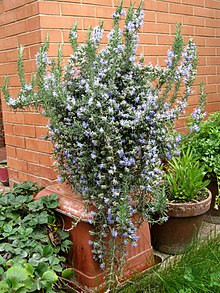User:Kmbaus22/Rosemary
| This is the sandbox page where you will draft your initial Wikipedia contribution.
If you're starting a new article, you can develop it here until it's ready to go live. If you're working on improvements to an existing article, copy only one section at a time of the article to this sandbox to work on, and be sure to use an edit summary linking to the article you copied from. Do not copy over the entire article. You can find additional instructions here. Remember to save your work regularly using the "Publish page" button. (It just means 'save'; it will still be in the sandbox.) You can add bold formatting to your additions to differentiate them from existing content. |
Article Draft[edit]
Lead[edit]
Salvia rosmarinus (/ˈsælviə ˌrɒsməˈraɪnəs/[1][2]), commonly known as rosemary, is a shrub with fragrant, evergreen, needle-like leaves and white, pink, purple, or blue flowers. It is native to the Mediterranean region, as well as Portugal and northwestern Spain[3]. Until 2017, it was known by the scientific name Rosmarinus officinalis (/ˌrɒsməˈraɪnəs əˌfɪsɪˈneɪlɪs/[2]), now a synonym.[4]
It is a member of the sage family Lamiaceae, which includes many other medicinal and culinary herbs. The name rosemary derives from Latin ros marinus (lit. 'dew of the sea').[5][6] Rosemary has a fibrous root system.[7]
Article body[edit]
Description[edit]


Rosemary is an aromatic evergreen shrub with leaves similar to hemlock needles. It is native to the Mediterranean region,[8] but is reasonably hardy in cool climates. Special cultivars like 'Arp' can withstand winter temperatures down to about −20 °C (−4 °F).[9] It can withstand droughts, surviving a severe lack of water for lengthy periods.[10] It is considered a potentially invasive species and its seeds are often difficult to start, with a low germination rate and relatively slow growth, but the plant can live as long as 35 years.[11][12]
Forms range from upright to trailing;[8] the upright forms can reach between 4-6 feet tall[3]. The leaves are evergreen, 2–4 cm (3⁄4–1+1⁄2 in) long and 2–5 mm (1⁄16–3⁄16 in) broad, green above, and white below, with dense, short, woolly hair.[8]
The plant flowers in spring and summer in temperate climates, but the plants can be in constant bloom in warm climates; flowers are white, pink, purple or deep blue.[8] The branches are dotted with groups of 2 to 3 flowers down its length.[3] Rosemary also has a tendency to flower outside its normal flowering season; it has been known to flower as late as early December, and as early as mid-February (in the northern hemisphere).[13]
Usage[edit]


Aside from its usage in the fragrance industry, Rosemary is not only used as a decorative plant in gardens, but also cultivated for practical applications, such as medicine and cooking. When the plant is fully grown, the leaves, twigs, and flowering apices are often extracted for use in these areas.[14] The leaves are used to flavor various foods, such as stuffing and roasted meats.[15] In order to harvest from the plant, the bush should be matured 2-3 years to ensure it is large enough to withstand it.[3] The amount harvested should not exceed 20% of the growth in order to preserve the plant.[3]
References[edit]
- ^ "Salvia". Merriam-Webster.com Dictionary.
- ^ a b "Rosemary". California Plant Names. Retrieved December 19, 2022.
- ^ a b c d e Mahr, Susan. "Rosemary, Rosemarinus officinalis". Wisconsin Horticulture. Retrieved May 2, 2024.
- ^ Drew; et al. (February 2017). "Salvia united: The greatest good for the greatest number".
- ^ Room, Adrian (1988). A Dictionary of True Etymologies. Taylor & Francis. p. 150. ISBN 978-0-415-03060-1.
- ^ Wedgwood, Hensleigh (1855). "On False Etymologies". Transactions of the Philological Society (6): 66.
- ^ "Rosmarinus officinalis (rosemary)". Centre for Agriculture and Bioscience International. 3 January 2018. Retrieved 1 April 2023.
- ^ a b c d "Rosmarinus officinalis (rosemary)". Centre for Agriculture and Bioscience International. 3 January 2018. Retrieved 1 April 2023.
- ^ Tucker, Arthur O.; Maciarello, Michael J. (September 1986). "The essential oils of some rosemary cultivars". Flavour and Fragrance Journal. 1 (4–5): 137–142. doi:10.1002/ffj.2730010402.
- ^ "How to Grow Rosemary". Garden Action. Retrieved 10 November 2011.
- ^ Shepherd, Lizz. The Complete Guide to Growing Vegetables, Flowers, Fruits, and Herbs from Containers. Page 127. Retrieved on 6 Oct. 2023. "Rosemary seeds can be hard to start, with a slow germinating time and a low germination rate, which means many seeds do not develop into plants."
- ^ Federal Register. Volume 52, Issues 13-20 - Page 2228. Retrieved on 6 Oct. 2023. "Mature rosemary approaches senescence at an age of 30-35 years…it releases toxic chemicals into the soil that inhibit or prevent the growth of most other plants, resulting in areas of relatively bare, open sand between the shrubs."
- ^ McCoy, Michael (27 June 2012). "The good graces of rosemary". The Gardenist. Archived from the original on 16 November 2018. Retrieved 10 April 2015.
- ^ Burlando, Bruno; Verotta, Luisella; Cornara, Laura; Bottini-Massa, Elisa (2010). Herbal Principles in Cosmetics Properties and Mechanisms of Action. Boca Raton, Florida: CRC Press. p. 303. ISBN 978-1-4398-1214-3.
- ^ "About the Herb Rosemary and Uses". The Spruce Eats. Retrieved 2021-01-29.
